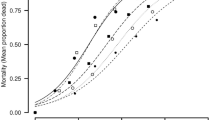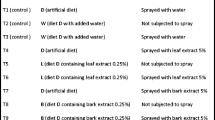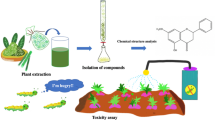Abstract
Effects of foliage extracts of goat weed, Ageratum conyzoides (Family: Asteraceae) on feeding, oviposition and egg hatchability of diamondback moth, Plutella xylostella were assessed under standard laboratory conditions. Bioassays using aqueous, methanol and hexane crude extracts were conducted in no-choice and choice conditions. The larval feeding on 0.5% hexane extract treated leaf surface reduced to more than half relative to control in the choice condition; however, complete inhibition of feeding was recorded at 2% and higher concentration of extract. In no-choice bioassays, the larval feeding consistently decreased with increasing concentration of the hexane extract. Larval feeding on methanol extract treated leaves was also significantly reduced, although in the concentration dependent manner in both choice and no-choice bioassays. Likewise, the aqueous extract also reduced larval feeding at 3%, 4% and 5% concentrations of extracts in both no-choice and choice bioassays. The Antifeedant Index (AFI) for hexane extract was 100 at 2% concentration, while AFI values were 78.4 and 41.5 for 5% concentration of methanol and aqueous extracts, respectively. The egg laying on the leaf surface treated with hexane and methanol extracts was significantly reduced in the concentration dependent manner, as compared to the control in both choice and no-choice bioassays. However, the aqueous extract did not affect egg laying. The egg hatchability was completely inhibited at higher concentrations of the hexane extract, but not at any concentration of the methanol and aqueous extracts. The oviposition Deterrent Index values for the hexane and methanol extracts were statistically similar, however. These results indicate that the crude hexane and methanol extracts of A. conyzoides foliage could potentially be used for the management of diamondback moth.


Similar content being viewed by others
References
Agboyi LK, Ketoh GK, Martin T, Glitho IA (2016) Pesticide resistance in Plutella xylostella (Lepidoptera: Plutellidae) populations from Togo and Benin. Int J Trop Insect Sc 36(4):204–210. https://doi.org/10.1017/S1742758416000138
Amelot MEA, Avendaño M, Aubert L, Avila JL (2003) Repellency and feeding deterrence activity of Ageratum conyzoides against the stored grain pests Tribolium castaneum and Sitophilus oryzae. Active Plant Parts Compos Cienc 11(1):61–76
Badenes-Pérez FR, Reichelt M, Gershenzon J, Heckel DG (2011) Phylloplane location of glucosinolates in Barbarea spp. (Brassicaceae) and misleading assessment of host suitability by a specialist herbivore. New Phytol 189(2):549–556. https://doi.org/10.1111/j.1469-8137.2010.03486.x
Badenes-Pérez FR, Reichelt M, Gershenzon J, Heckel DG (2013) Interaction of glucosinolate content of Arabidopsis thaliana mutant lines and feeding and oviposition by generalist and specialist lepidopterans. Phytochemistry 86:36–43. https://doi.org/10.1016/j.phytochem.2012.11.006
Basukriadi A, Wilkins RM (2014) Oviposition deterrent activities of Pachyrhizus erosus seed extract and other natural products on Plutella xylostella (Lepidoptera : Plutellidae). J Insect Sci 14(1):244. https://doi.org/10.1093/jisesa/ieu106
Bhathal SS, Singh D, Dhillon RS, Nayyar K (1991) Ovicidal effect of neem oil and plant extract of Ageratum conyzoides linn. on Dysdercus koenigii fab. J Insect Sci 4(2):185–186
Bouda H, Tapondjou LA, Fontem DA, Gumedzoe MYD (2001) Effect of essential oils from the leaves of Ageratum conyzoides, Lantana camara and Chromolaena odorata on the mortality of Sitophilus zeamais (Coleoptera: Curculionidae). J Stored Prod Res 37(2):103–109
Boulogne I, Petit P (2012) Insecticidal and antifungal chemicals produced by plants. A review: Environ Chem Lett 10(4):325–347. https://doi.org/10.1007/s10311-012-0359-1
Bowers WS, Feldlaufer MF (1982) In vitro inactivation of Tenebrio molitor corpora allata by a synthetic precocene analogue. Gen Comp Endocrinol 47(1):120–124
Champagne DE, Koul O, Isman MB, Scudder GGE, Towers GHN (1992) Biological activity of limonoids from the Rutales. Phytochemistry 31(2):377–394. https://doi.org/10.1016/0031-9422(92)90003-9
Chapman RF (1995) Mechanics of food handling by chewing insects. In: Chapman RF, de Boer G (eds) Regulatory mechanisms in insect feeding. Chapman & Hall, New York, pp 3–31
Charleston DS, Kfir R, LEM V, Dicke M (2005) Behavioural responses of diamondback moth Plutella xylostella (Lepidoptera: Plutellidae) to extracts derived from Melia azedarach and Azadirachta indica. Bull Entomol Res 95(5):457–465. https://doi.org/10.1079/BER2005377
Chen CC, Chang SJ, Cheng LL, Hou RF (1996) Deterrent effect of the chinaberry extract on oviposition of the diamondback moth, Plutella xylostella (L.) (Lep., Yponomeutidae). J Appl Ent 120:165–169. https://doi.org/10.1111/j.1439-0418.1996.tb01585.x
Facknath S, Lalljee B (2008) Study of various extracts of Ayapana triplinervis for their potential in controlling three insect pests of horticultural crops. Tropicultura 26(2):119–124
Fagonee I, Umrit G (1981) Anti-gonadotropic hormones from the goat weed, Ageratum conyzoides. Insect Sci Appl 1(4):373–376
Furlong MJ, Wright DJ, Dosdall LM (2013) Diamondback moth ecology and management: problems, progress, and prospects. Annu Rev Entomol 58:517–541. https://doi.org/10.1146/annurev-ento-120811-153605
Gbolade A, Onayade O, Ayinde BA (1999) Insecticidal activity of Ageratum conyzoides L. volatile oil against Callosobruchus maculatus F. in seed treatment and fumigation laboratory tests. Insect Sci Applic 19(2–3):237–240. https://doi.org/10.1017/S1742758400019536
González-Coloma A, Guadaño A, Tonn CE, Sosa ME (2005) Antifeedant/insecticidal terpenes from Asteraceae and Labiatae species native to Argentinean semi-arid lands. Z Naturforsch C 60(11–12):855–861
Henniges-Janssen K, Heckel DG, Groot AT (2014) Preference of diamondback moth larvae for novel and original host plant after host range expansion. Insects 5(4):793–804. https://doi.org/10.3390/insects5040793
Hough-Goldstein JA, Hahn SP (1992) Antifeedant and oviposition deterrent activity of an aqueous extract of Tanacetum vulgare L. on two cabbage pests. Environ Entomol 21(4):837–844. https://doi.org/10.1093/ee/21.4.837
Huang X, Renwick JAA (1994) Cardenolides as oviposition deterrents to two Pieris species: structure-activity relationships. J Chem Ecol 20(5):1039–1051. https://doi.org/10.1007/BF02059740
Ibrahim MA, Oksanen EJ, Holopainen JK (2004) Effects of limonene on growth and physiology of cabbage and carrot plants. J Sci Food Agric 84(11):1319–1326. https://doi.org/10.1002/jsfa.1819
Isman MB (1992) A physiological perspective. In: Roitberg BD, Isman MB (eds) Insect chemical ecology: an evolutionary approach. Chapman and Hall, New York, pp 156–176
Isman MB (1993) Growth inhibitory and antifeedant effects of azadirachtin on six noctuids of regional economic importance. Pestic Sci 38:57–63. https://doi.org/10.1002/ps.2780380109
Isman MB (1995) Leads and prospects for the development of new botanical insecticides. Rev Toxicol 3:1–20 AGR:IND20587890
Kraikrathok C, Ngamsaeng S, Bullangpoti V, Pluempanupat W, Koul O (2013) Bioefficacy of some Piperaceae plant extracts against Plutella xylostella L. (Lepidoptera:Plutellidae). Commun Agric Appl Biol Sci 78(2):305–310
Li Z, Feng X, Liu SS, You M, Furlong MJ (2016a) Biology, ecology and Management of Diamondback Moth in China. Annu Rev Entomol 61:277–296
Li Z, Zalucki MP, Yonow T, Kriticos DJ (2016b) Population dynamics and management of diamondback moth (Plutella xylostella) in China: the relative contributions of climate, natural enemies and cropping patterns. Bull Entomol Res 102(2):197–214. https://doi.org/10.1017/S0007485315001017
Liu SS, Li YH, Liu YQ, Zalucki MP (2005) Experience-induced preference for oviposition repellents derived from a non-host plant by a specialist herbivore. Ecol Lett 8(7):722–729. https://doi.org/10.1111/j.1461-0248.2005.00776.x
Liu SS, Li YH, Lou YG (2006) Non-host plant extracts reduce oviposition of Plutella xylostella (Lepidoptera: Plutellidae) and enhance parasitism by its parasitoid Cotesia plutellae (Hymenoptera: Broconidae). Bull Entomol Res 96(4):373–378. https://doi.org/10.1079/BER2006441
Mahmood I, Imadi SR, Shazadi K, Gul A (2015) Effects of pesticides on environment: pp. 253-269. In: Hakeem KR et al (eds) Plant, Soil and Microbes. Springer International Publishing, Cham. https://doi.org/10.1007/978-3-319-27455-3_13
Morallo-Rejesus M (1986) Botanical pesticides against the diamondback moth, pp. 241-255. In: Talekar, NS, and Griggs TD (eds) Diamondback moth management. Proceedings of the first international workshop, 11-15, March, 1985, Asian Vegetables Research and Develoment Centre; Taiwan
Passreiter CM, Isman MB (1997) Antifeedant bioactivity of sesquiterpene lactones from Neurolaena lobata and their antagonism by gamma aminobutyric acid. Biochem Syst Ecol 25(5):371–377. https://doi.org/10.1016/S0305-1978(97)00023-9
Ragesh PR (2011) Biological activity of Ageratum conyzoides (L.) (Asteraceae) extracts against gram podborer, Helicoverpa armigera (Hubner) (Lepidoptera: Noctuidae). Ph.D. Thesis, University of Delhi, Delhi, India
Ragesh PR, Bhutia TN, Ganta S, Singh AK (2016) Repellent, antifeedant and toxic effects of Ageratum conyzoides (Linnaeus) (Asteraceae) extract against Helicoverpa armigera (Hübner) (Lepidoptera:Noctuidae). Arch Phytopathol Plant Prot 49(1-4):19–30. https://doi.org/10.1080/03235408.2016.1147123
Sangha JS, Astatkie T, Cutler GC (2017) Ovicidal, larvicidal, and behavioural effects of some plant essential oils on diamondback moth (Lepidoptera: Plutellidae). Can Entomol 00:1–10. https://doi.org/10.4039/tce.2017.13
Saxena RC, Jayashree S, Padma S, Dixit OP (1994) Evaluation of growth disrupting activity of Ageratum conyzoides crude extract on Culex quinquefasciatus. J Environ Biol 15(1):67–74
Schoonhoven LM, van Loon JJA, Dicke M (2005) Insect-plant biology, 2nd edn. Oxford University Press, Oxford
Shelton AM, Robertson JL, Tang JD, Perez C, Eigenbrode SD, Preisler HK, Wilsey WT, Cooley RJ (1993) Resistance of diamondback moth (Lepidoptera: Plutellidae) to Bacillus thuringiensis subspecies in the field. J Econ Entomol 86:697–705
Singh S, Rao PJ (2000) Effect of Ageratum conyzoides on development and reproduction of Spodoptera litura. Indian J Entomol 62(3):231–238
Susurluk H, Caliskan Z, Gurkan O, Kirmizigul S, Goren N (2007) Antifeedant activity of some Tanacetum species and bioassay guided isolation of the secondary metabolites of Tanacetum cadmium ssp. (Compositae). Ind Crop Prod 26(2):220–228. https://doi.org/10.1016/j.indcrop.2007.04.002
Tabashnik BE, Cushing NL, Finson N, Johnson MW (1990) Field development of resistance to Bacillus thuringiensis in diamondback moth (Lepidoptera: Plutellidae). J Econ Entomol 84:49–55
Talekar NS, Shelton AM (1993) Biology, ecology, and management of the diamondback moth. Annu Rev Entomol 38:275–301. https://doi.org/10.1146/annurev.en.38.010193.001423
Tandon M, Shukla YN, Tripathi AK, Singh SC (1998) Insect antifeedant principles from Vernonia cinerea. Phytother Res 12(3):195–199. https://doi.org/10.1002/(SICI)1099-1573(199805)12:3<195::AID-PTR223>3.0.CO;2-%23
Thorsteinson AJ (1953) The chemotactic responses that determine host specificity in an oligophagous insect Plutella maculipennis (Curt.) Lepidoptera:Plutellidae. Can J Zool 31(1):52–72. https://doi.org/10.1139/z53-006
Verkerk RHJ, Wright DJ (1996) Multitrophic interactions and management of the diamondback moth: a review. Bull Entomol Res 86(3):205–216. https://doi.org/10.1017/S0007485300052482
Xie YS, Isman MB, Gunning P, MacKinnon S, Arnason JT, Taylor DR, Sanchez P, Hasbun C, Towers GHN (1994) Biological activity of extracts of Trichilia species and the limonoid Hirtin against lepidopteran larvae. Biochem Syst Ecol 22(2):129–136. https://doi.org/10.1016/0305-1978(94)90003-5
Zalucki MP, Shabbir A, Silva R, Adamson D, Shu-Sheng L, Furlong MJ (2012) Estimating the economic cost of one of the world's major insect pests, Plutella xylostella (Lepidoptera: Plutellidae): just how long is a piece of string? J Econ Entomol 105(4):1115–1129. https://doi.org/10.1603/EC12107
Acknowledgements
The authors wish to thank University Grant Commission, Council for Scientific and Industrial Research and University of Delhi to provide financial support for this study. We also thank to National Seed Bank, Indian Agriculture Research Institute, New Delhi to provide Cauliflower seeds of required cultivar.
Author information
Authors and Affiliations
Corresponding author
Ethics declarations
Conflict of interest
The authors declare that they have no conflict of interest.
Additional information
Publisher’s note
Springer Nature remains neutral with regard to jurisdictional claims in published maps and institutional affiliations.
Rights and permissions
About this article
Cite this article
Vats, T.K., Rawal, V., Mullick, S. et al. Bioactivity of Ageratum conyzoides (L.) (Asteraceae) on feeding and oviposition behaviour of diamondback moth Plutella xylostella (L.) (Lepidoptera: Plutellidae). Int J Trop Insect Sci 39, 311–318 (2019). https://doi.org/10.1007/s42690-019-00042-5
Received:
Accepted:
Published:
Issue Date:
DOI: https://doi.org/10.1007/s42690-019-00042-5




